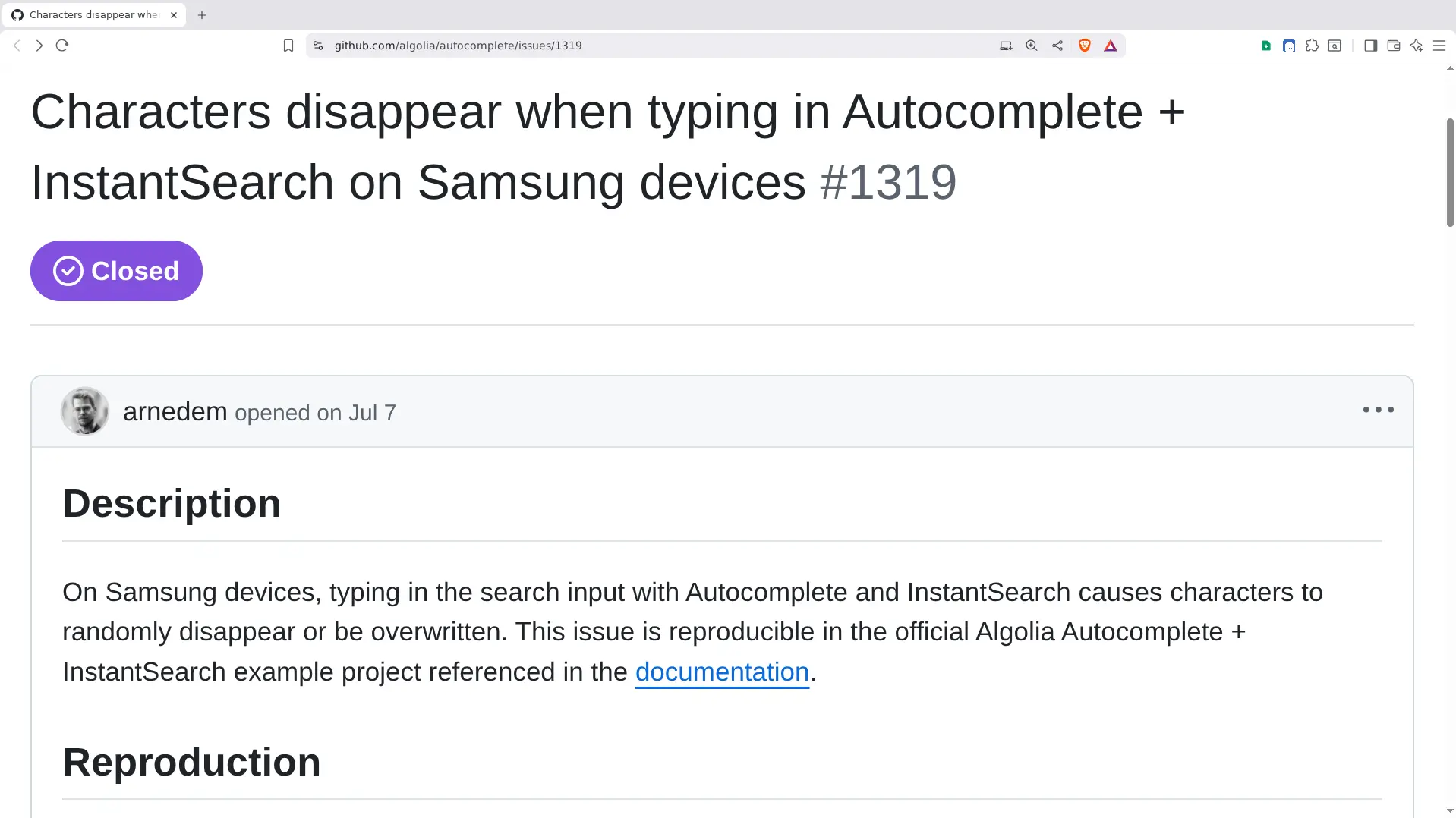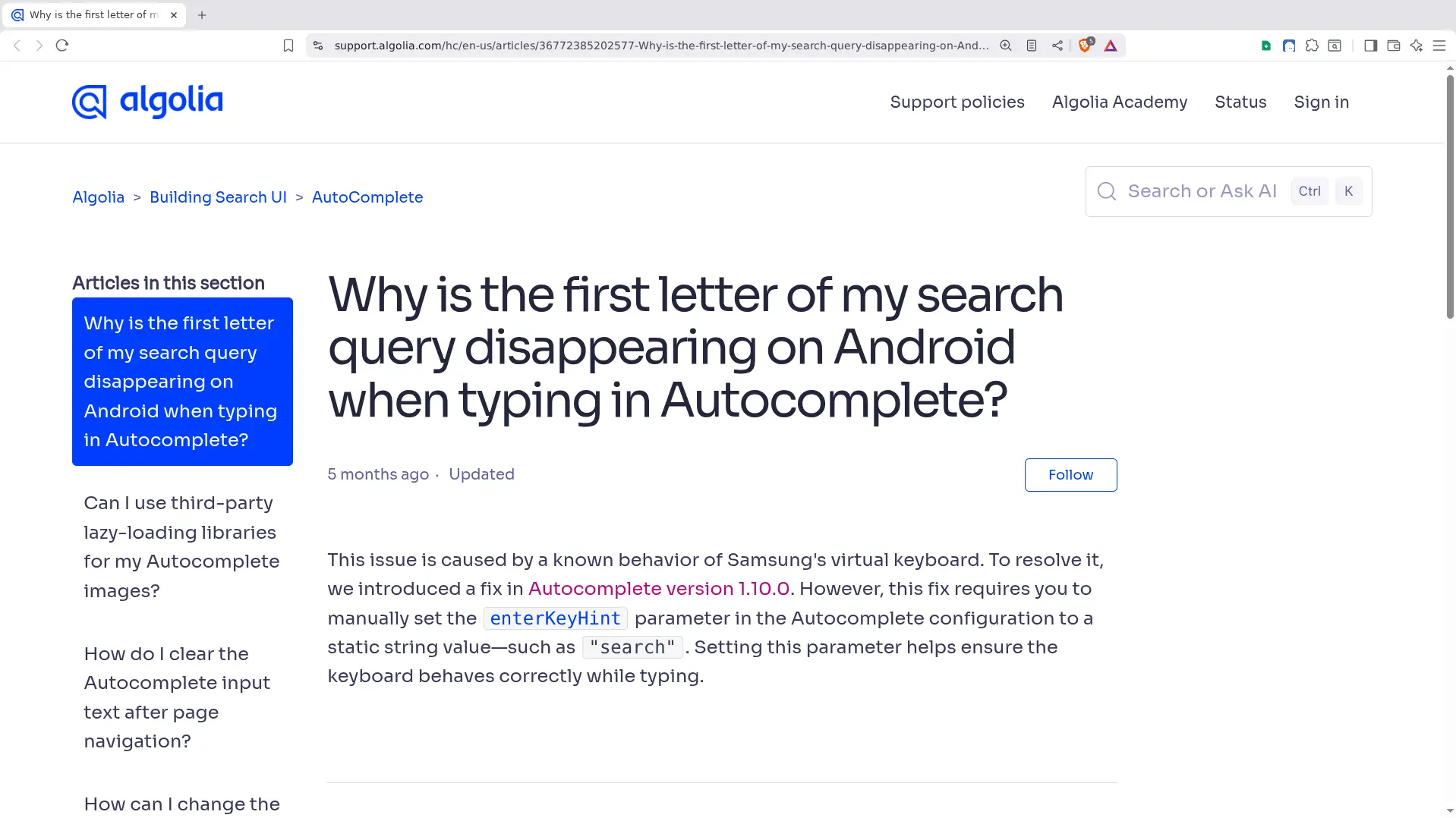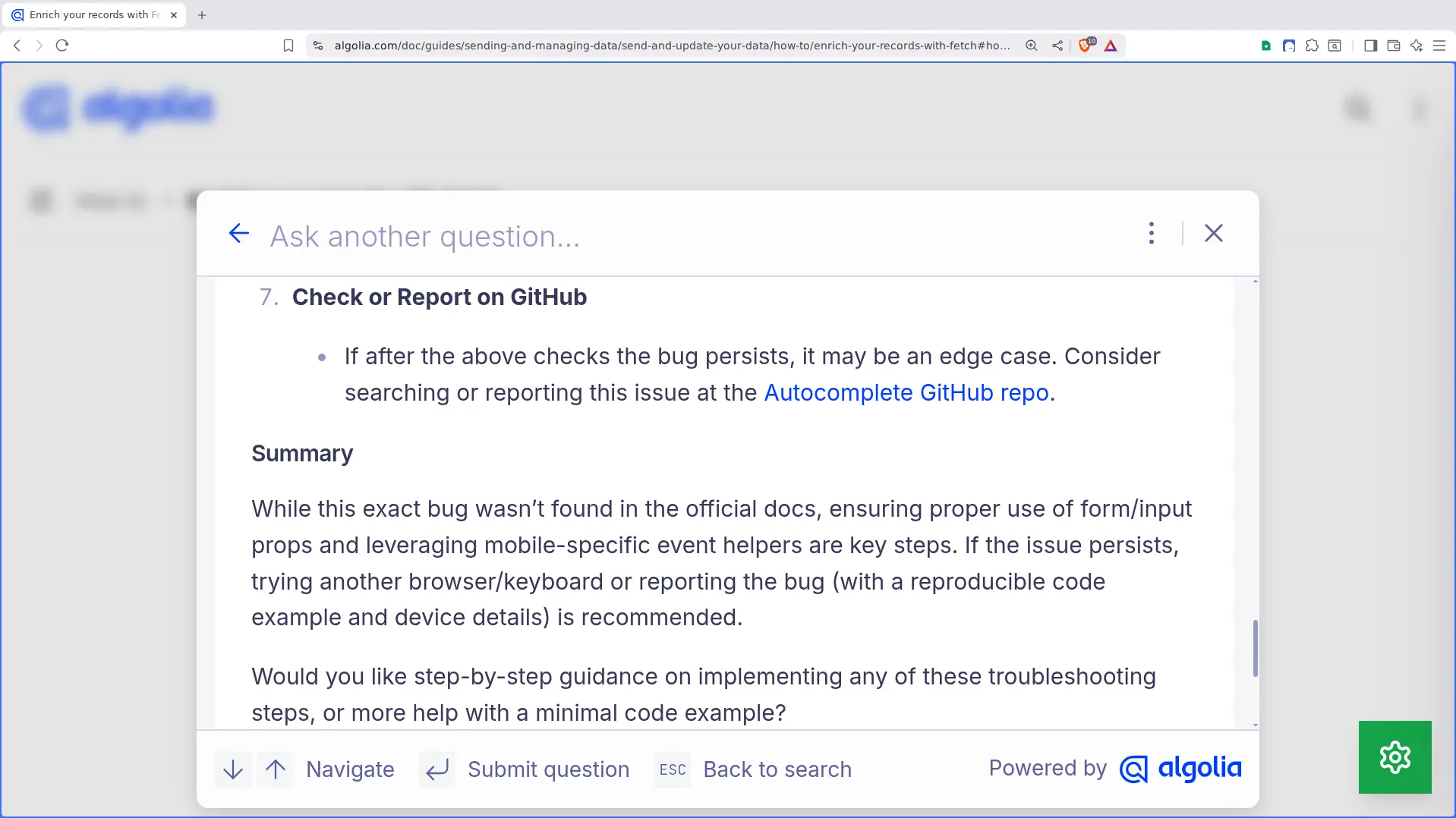Improve your docs by giving your AI assistant the project's issues
Recently, I ran into a virtual keyboard bug while using Algolia's Autocomplete ↗ library that was new to me: on Samsung phones, characters were disappearing while typing.
This is a known bug with a simple fix: set the
enterKeyHint parameter to
"search" when you
instantiate Autocomplete.
Simple enough, yet I couldn't get it solved by LLMs. I had to do it the old way, by searching the library's GitHub issues. There I found this issue ↗

which points to this article ↗ on the Algolia support site that explains the problem:

I don't mind digging through issue trackers, but I believe LLMs could have solved my problem if the library authors had used the following strategy:
-
Properly documenting that the
enterKeyHintparameter was added to fix that Samsung virtual keyboard quirk. Right now, the docstring ↗ forenterKeyHintsays: "The action label or icon to present for the enter key on virtual keyboards." It lists 7 possible values. This did not help me, and it did not help the LLM either.
-
Feeding the Algolia AI assistant with Autocomplete's GitHub issues. That way, LLMs could answer the common mistakes we make as developers when using new libraries. This would save a lot of time and greatly improve the developer experience. Here's what I got using this prompt:

LLMs are not to blame for the lack of information they sometimes suffer from.
Let's help them so they can help us.
That's all I have for today! Talk soon 👋
No spam. Unsubscribe anytime.
Prompt I used for Samsung virtual keyboard bug with Autocomplete library
I have one really annoying bug with Autocomplete
(https://github.com/algolia/autocomplete/) that breaks the whole
search experience.
It does not happen on my laptop. It only happens on my mobile phone. It
is a Samsung running Android.
1. When I type in the search bar, characters get removed. For instance,
if I type "f" then "o", "f" gets removed, and only "o" stays in the
search input.
2. At first, I thought it was because I was typing fast. But no, it
happens at any typing speed.
3. Then I thought it was because lunr might be slow with 1 or 2
characters, since there are too many matches. But it is not due to
lunr, because we only call search when there are at least 3
characters.
Do you have any idea what is going on? Is it a known bug of
autocomplete.js with Android? What can I do to troubleshoot it? Do you
have a fix for it?
It is weird that it works perfectly on my laptop. I have no clue.Download Autocomplete issues in JSON and Markdown formats
With ghapi
If you want to try the script yourself:
-
Add your GitHub token to the
.envfile:GITHUB_TOKEN=... -
Run the following commands:
$ uv init $ uv add ghapi python-dotenv $ uv run fetch_github_issues.py -
The Autocomplete issues are saved:
-
in JSON in the file
autocomplete-issues.json -
in Mardown in the file
autocomplete-issues.md
-
# fetch_github_issues.py
import json
import os
import logging
from dotenv import load_dotenv
from ghapi.all import GhApi, paged
logging.basicConfig(level=logging.INFO, format="%(levelname)s: %(message)s")
load_dotenv()
token = os.getenv("GITHUB_TOKEN")
owner = "algolia"
repo = "autocomplete"
api = GhApi(owner=owner, repo=repo, token=token)
# Fetch all issues (including pull requests)
issues_and_pull_requests = []
for page in paged(
api.issues.list_for_repo, owner=owner, repo=repo, state="all", per_page=100
):
issues_and_pull_requests.extend(page)
# Sort by issue number
issues_and_pull_requests = sorted(
issues_and_pull_requests, key=lambda issue: issue.number
)
issues = []
for issue in issues_and_pull_requests:
if getattr(issue, "pull_request", None) is not None:
continue
logging.info(issue.html_url)
issues.append(
{
"html_url": issue.html_url,
"title": issue.title,
"body": issue.body,
}
)
# Save issues in JSON format
with open("autocomplete-issues.json", "w", encoding="utf-8") as f:
json.dump(issues, f, ensure_ascii=False, indent=2)
# Save issues in Markdown format
def format_issue(issue):
title = issue["title"]
body = issue["body"]
url = issue["html_url"]
return f"# {title}\nSource: {url}\n\n{body}\n\n"
issues_md = "".join(map(format_issue, issues))
with open("autocomplete-issues.md", "w", encoding="utf-8") as f:
f.write(issues_md)With pygithub
If you want to try the script yourself:
-
Add your GitHub token to the
.envfile:GITHUB_TOKEN=... -
Run the following commands:
$ uv init $ uv add pygithub python-dotenv $ uv run fetch_github_issues.py -
The Autocomplete issues are saved:
-
in JSON in the file
autocomplete-issues.json -
in Mardown in the file
autocomplete-issues.md
-
import json
import os
import logging
from dotenv import load_dotenv
from github import Github, Auth
logging.basicConfig(level=logging.INFO, format="%(levelname)s: %(message)s")
load_dotenv()
token = os.getenv("GITHUB_TOKEN")
gh = Github(auth=Auth.Token(token))
gh.get_user().login
repo = gh.get_repo("algolia/autocomplete")
# Fetch and sort all issues (including pull requests)
issues_and_pull_requests = sorted(
repo.get_issues(state="all"), key=lambda issue: issue.number
)
issues = []
for issue in issues_and_pull_requests:
if issue.pull_request is not None:
continue
logging.info(issue.html_url)
issues.append(
{
"html_url": issue.html_url,
"title": issue.title,
"body": issue.body,
}
)
# Save issues in JSON format
with open("autocomplete-issues.json", "w", encoding="utf-8") as f:
json.dump(issues, f, ensure_ascii=False, indent=2)
# Save issues in Markdown format
def format_issue(issue):
title = issue["title"]
body = issue["body"]
url = issue["html_url"]
return f"# {title}\nSource: {url}\n\n{body}\n\n"
issues_md = "".join(map(format_issue, issues))
with open("autocomplete-issues.md", "w", encoding="utf-8") as f:
f.write(issues_md)References
-
GitHub
-
PyGithub
-
ghapi
